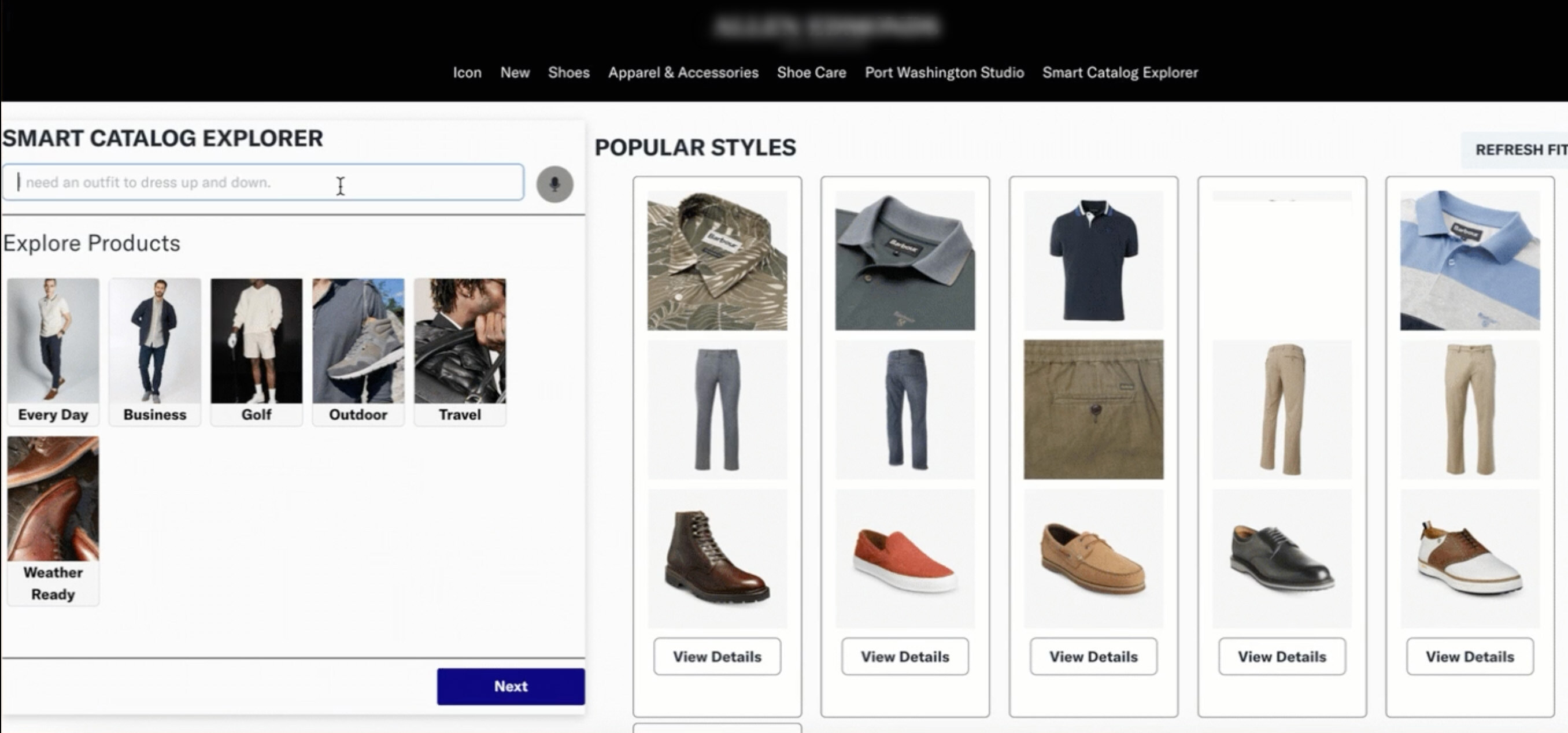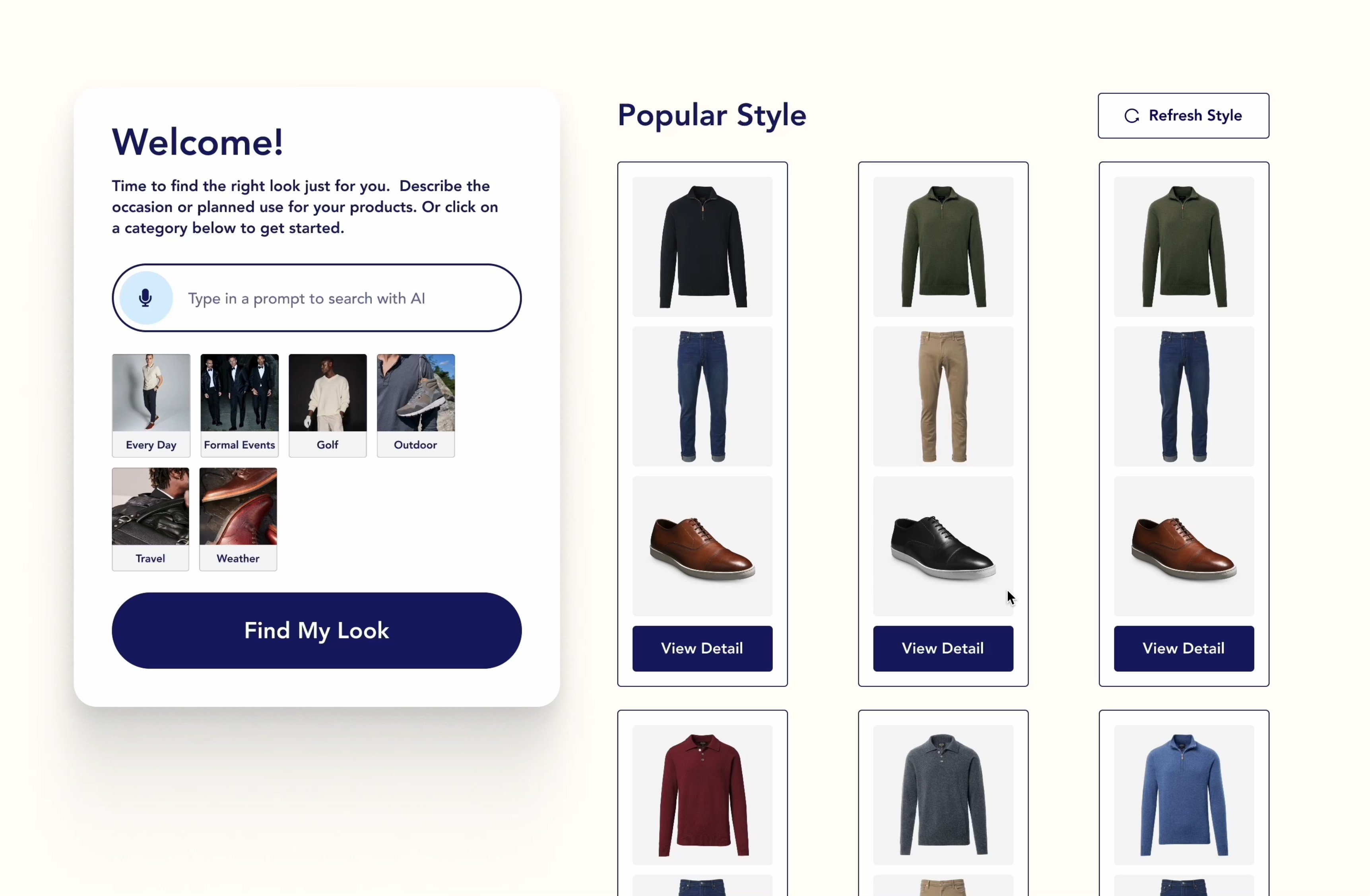How AI-Driven Product Discovery Differs From Keyword Search
Summary / TL;DR
-
AI product discovery uses natural language processing and intent recognition instead of relying on exact keyword matches.
-
Semantic search understands customer needs and context, connecting buyers with relevant products even with different terminology.
-
Traditional keyword search misses 40-60% of potential matches due to vocabulary gaps between customers and product catalogs.
-
Machine learning algorithms continuously improve product recommendations based on customer behavior and successful purchase patterns.
Understanding the Fundamental Difference: Discovery vs. Search
The eCommerce landscape is changing quickly. The traditional keyword-based search is giving way to more advanced AI product discovery systems. While conventional search requires customers to know exactly what they're looking for, AI-driven discovery helps them find products they didn't even know existed, often products that perfectly match their needs.
Key difference: Search answers "Where is X?" while discovery answers "What should I consider?" This fundamental shift from reactive to proactive product finding is revolutionizing how manufacturers and retailers connect customers with their ideal products.
The Limitations of Traditional Keyword Search
Why Keyword Search Falls Short in eCommerce
Traditional keyword search operates on exact or close matches between customer queries and product descriptions. This approach creates several challenges for both customers and businesses:
Customer-side limitations:
- Must know specific product names or technical terms
- Limited by personal vocabulary and industry knowledge
- Often miss relevant products due to terminology mismatches
- Struggle with complex or multi-attribute requirements
Business-side challenges:
- Heavily dependent on SEO optimization and keyword stuffing
- Miss sales opportunities when customers use unexpected terms
- Difficult to showcase product relationships and complementary items
- Limited ability to guide customers toward better-fit products
The Semantic Keyword Gap Problem
One of the biggest issues with semantic search vs keyword approaches is the semantic gap, the disconnect between how customers think about their needs and how businesses describe their products.
For example, a customer might search for "heavy-duty outdoor furniture" while the manufacturer catalogs the same products under "commercial-grade patio equipment." This creates a disconnect between the buyer's needs and the store's offerings, causing a barrier to product discovery.
How AI Product Discovery Works

Natural Language Processing (NLP) Revolution
Modern AI product discovery uses advanced Natural Language Processing to understand intent, context, and meaning rather than just matching keywords. This technology can interpret customer queries in natural, conversational language and connect them with relevant products, regardless of exact terminology matches.
Generally speaking, NLP capabilities include:
- Intent recognition - Understanding what customers actually want to accomplish
- Contextual analysis - Considering surrounding words and phrases for deeper meaning
- Synonym and variation handling - Recognizing different ways to express the same concept
- Multi-language support - Breaking down language barriers in global commerce
Semantic Understanding in Action
Unlike traditional eCommerce product search, AI-driven systems create semantic relationships between products, customer needs, and contextual factors. This process means the system interprets that a customer searching for "eco-friendly packaging solutions" might also be interested in:
- Biodegradable materials
- Recyclable containers
- Sustainable manufacturing processes
- Carbon-neutral shipping options
- Waste reduction technologies
This process help match customers with products that are of interest to them, even if they aren't yet aware of those particular products.
Advanced Technologies Behind AI Product Discovery
Intent Recognition Technology
Intent recognition goes beyond keyword matching to understand the customer's underlying purpose. This technology analyzes multiple signals to determine what customers really want:
Data sources for intent recognition:
- Search query analysis
- Browsing behavior patterns
- Previous purchase history
- Session duration and engagement
- Device and location context
- Time-based patterns
AI integration across platforms and channels is making the concept of intent-based discovery more prevalent across forms of search, including organic search (SEO), Google ads, online shopping, and more.
Machine Learning Models
AI product discovery systems employ sophisticated machine learning algorithms that continuously improve based on customer interactions and outcomes:
|
ML Technology |
Function |
Benefit |
|
Collaborative Filtering |
Finds patterns in customer behavior |
Discovers unexpected product relationships |
|
Content-Based Filtering |
Analyzes product attributes |
Matches features to customer preferences |
|
Deep Learning Networks |
Processes complex, multi-dimensional data |
Handles nuanced customer requirements |
|
Reinforcement Learning |
Optimizes based on conversion outcomes |
Continuously improves recommendation accuracy |
Vector Space Modeling

*Image from opendatascience.com
There's a lot that goes into vector search, but for the purposes of this article we'll keep it simple. Modern AI product discovery uses vector embeddings to represent both products and customer queries in a multi-dimensional space.
Products with similar characteristics cluster together, making it easier to find alternatives and complementary items, even when they don't share obvious keywords. This creates the opportunity for natural, conversational product discovery that takes into consideration buyer intent to provide personalized product recommendations.
Semantic Search vs Keyword: Real-World Applications

B2B Manufacturing Scenarios
For B2B manufacturers, the difference between AI product discovery and traditional search becomes particularly pronounced.
Traditional keyword search scenario: Customer searches: "industrial pump 50 GPM" Results: Only pumps specifically tagged with "50 GPM" in descriptions
AI product discovery scenario: Customer searches: "pump for cooling system in textile manufacturing" Results: Relevant pumps based on application, industry requirements, flow rates suitable for textile cooling, and compatible accessories
Complex Product Configuration
When dealing with configurable products, semantic search vs keyword capabilities become even more critical. AI systems can understand complex requirements expressed in natural language.
Example customer query: "I need equipment that can handle high-temperature processing in a clean room environment with minimal maintenance requirements."
AI analysis:
- High-temperature = Products rated for extreme heat
- Clean room = Meets contamination control standards
- Minimal maintenance = Low-maintenance or self-maintaining systems
- Processing = Manufacturing or production equipment
This complex interpretation of the user's query allows retailers and manufacturers to successfully connect the buyer with the products that best match their needs in that moment, leading to higher average order value and increased sales.
The Business Impact of AI Product Discovery
Improved Customer Experience Metrics
Companies implementing AI product discovery typically see significant improvements in key customer experience indicators:
Discovery effectiveness:
- 90% reduction in zero-result searches with AI-powered search implementation1
- 37% increase in conversion rates with advanced site search (Lacoste case study)2
- 43% increase in eCommerce site conversions through search optimization3
- 20% increase in visitor engagement time with optimized design and AI-powered experiences4
Revenue and Conversion Benefits
The business impact of switching from traditional eCommerce product search to AI-driven discovery extends beyond customer satisfaction:
Financial improvements:
- Higher average order values through better product matching
- Increased cross-sell and upsell opportunities
- Reduced customer acquisition costs through improved retention
- Enhanced customer lifetime value through better experiences
Competitive Advantages
Organizations leveraging AI product discovery gain several competitive advantages:
- Market differentiation through superior customer experience
- Inventory optimization by understanding actual customer demand
- Product development insights from analyzing search patterns and intent
- Operational efficiency through automated customer guidance
Technical Considerations When Implementing AI-driven Product Discovery
Integration with Existing Systems
Implementing AI product discovery requires careful integration with existing eCommerce and inventory management systems:
Key integration points:
- Product information management (PIM) systems
- Customer relationship management (CRM) platforms
- Enterprise resource planning (ERP) solutions
- Analytics and business intelligence tools
- Content management systems
Data Requirements and Quality
Successful AI product discovery depends heavily on data quality and comprehensiveness:
Essential data elements:
- Detailed product specifications and attributes
- Customer interaction and behavioral data
- Purchase history and transaction records
- Product relationships and compatibility information
- Inventory levels and availability data
Without having the required data and assets, training your AI model for successful AI product discovery will take longer and may lead to inconsistent results.
Best Practices for AI Product Discovery Implementation
Starting Your Transformation
Organizations transitioning from keyword-based search to AI product discovery should follow these best practices:
- Audit current search performance - Identify specific pain points and missed opportunities
- Define success metrics - Establish clear KPIs for measuring improvement
- Ensure data readiness - Clean and structure product data for AI consumption
- Plan gradual rollout - Implement AI discovery in phases to minimize risk
- Train customer-facing teams - Ensure staff understand the new capabilities
Optimizing for Continuous Improvement
AI product discovery systems improve over time through continuous learning:
Optimization strategies:
- Regular analysis of search queries and results
- A/B testing of different AI configurations
- Customer feedback integration and response
- Performance monitoring and adjustment
- Seasonal and trend-based calibration
The Future of Product Discovery

Emerging Technologies
The future of AI product discovery will incorporate even more sophisticated technologies:
Next-generation capabilities:
- Visual search integration - Finding products through images and videos
- Voice-activated discovery - Natural language interaction through voice interfaces
- Augmented reality integration - Visualizing products in real-world contexts
- Predictive discovery - Anticipating customer needs before they search
Industry-Specific Evolution
Different industries will see unique applications of AI product discovery:
- Manufacturing - Complex specification matching and compatibility checking
- Healthcare - Regulatory compliance and safety requirement integration
- Automotive - Part compatibility and system integration discovery
- Construction - Project-based product bundling and code compliance
Measuring Success: KPIs for AI Product Discovery
Essential Metrics to Track
Organizations implementing AI product discovery should monitor these key performance indicators:
|
Metric Category |
Specific KPIs |
Target Improvement |
|
Search Effectiveness |
Zero-result rate, Query refinement rate |
50-70% reduction |
|
Customer Engagement |
Time on site, Pages per session |
25-40% increase |
|
Conversion Performance |
Search-to-cart rate, Purchase completion |
20-35% improvement |
|
Business Impact |
Average order value, Customer lifetime value |
15-30% growth |
ROI Calculation Framework
To justify AI product discovery investments, consider both direct and indirect benefits:
Direct benefits:
- Increased conversion rates from better product matching
- Higher average order values through improved recommendations
- Reduced customer service costs through self-service capabilities
Indirect benefits:
- Improved customer satisfaction and loyalty
- Enhanced brand perception and market positioning
- Valuable customer insights for product development and marketing
The Strategic Advantage of AI Product Discovery
The shift from traditional keyword search to AI product discovery represents more than a technological upgrade. It's a fundamental reimagining of how customers and businesses connect. By using natural language processing, intent recognition, and semantic understanding, manufacturers and retailers can create discovery experiences that are intuitive, helpful, and valuable.
The semantic search vs keyword debate isn't really a debate anymore. It's a clear evolution toward more intelligent, customer-centric commerce. Organizations that embrace AI product discovery now will build sustainable competitive advantages through superior customer experiences, improved conversion rates, and deeper customer insights.
Success in modern eCommerce product search requires understanding that customers don't just want to find products. They want to discover solutions. AI product discovery makes that possible by bridging the gap between customer intent and product reality, creating commerce experiences that feel less like searching and more like having a conversation with a knowledgeable expert.
Sources:
17 Average Session Duration Statistics For eCommerce Stores
240+ stats on e-commerce search and KPIs - Algolia Blog | Algolia


